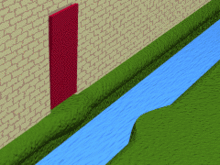Castle With Moat And Drawbridge


A drawbridge or draw-bridge is a type of moveable bridge typically at the entrance to a castle or tower surrounded by a moat. In some forms of English, including American English, the give-and-take drawbridge ordinarily refers to all types of moveable bridges, such as bascule bridges, vertical-lift bridges and swing bridges, but this article concerns the narrower historical definition of the term where the span is used in a defensive structure.[1]
As used in castles or defensive structures, drawbridges provide access across defensive structures when lowered, just can quickly be raised from inside to deny entry to an enemy force.
Castle drawbridges [edit]
Medieval castles were usually defended by a ditch or moat, crossed by a wooden bridge.[ii] In early castles the span might be designed to be destroyed or removed in the event of an set on, merely drawbridges became very common. A typical organization would have the drawbridge immediately outside a gatehouse, consisting of a wooden deck with one edge hinged or pivoting at the gatehouse threshold, so that in the raised position the bridge would be affluent against the gate, forming an additional barrier to entry. Information technology would be backed by one or more portcullises and gates. Access to the bridge could be resisted with missiles from machicolations to a higher place or pointer slits in flanking towers.
The span would be raised or lowered using ropes or chains attached to a windlass in a chamber in the gatehouse to a higher place the gate-passage. Just a very light bridge could be raised in this way without any form of counterweight, then some grade of bascule organization is usually found. The span may extend into the gate-passage beyond the pivot signal, either over a pit into which the internal portion can swing (providing a further obstruction to attack), or in the form of counterweighted beams that drop into slots in the floor.
The raising chains could themselves be attached to counterweights. In some cases, a portcullis provides the weight, every bit at Alnwick. Past the 14th century a bascule arrangement was provided by lifting artillery (called "gaffs") above and parallel to the bridge deck whose ends were linked by bondage to the lifting end of the bridge; in the raised position the gaffs would fit into slots in the gatehouse wall ("rainures") which can often yet be seen, as at Herstmonceux Castle. Inside the castle the gaffs were extended to bear counterweights, or might course the side-timbers of a stout gate which would be against the roof of the gate-passage when the drawbridge was down, only would shut against the gate-arch as the bridge was raised.[3]
In French republic, working drawbridges survive at a number of châteaux, including the Château du Plessis-Bourré.[4] In England, 2 working drawbridges remain in regular apply at Helmingham Hall, which dates from the early sixteenth century.[5]
Turning bridge [edit]
A span pivoted on central trunnions is called a turning bridge, and may or may not accept the raising chains feature of a drawbridge. The inner finish carried counterweights enabling it to sink into a pit in the gate-passage, and when horizontal the bridge would often be supported by stout pegs inserted through the side walls. This was a clumsy arrangement, and many turning bridges were replaced with more advanced drawbridges.[6]
Forts [edit]

Animation showing the performance of a drawbridge
Drawbridges were also used on forts with Palmerston Forts using them in the form of Guthrie rolling bridges.[7] [viii]
In art [edit]
Drawbridges take appeared in films as part of castle sets.[9] When the drawbridge needs to be functional this may present engineering challenges since the set may not be able to support the weight of the bridge in the conventional style.[9] One solution is to build the drawbridge from steel and concrete before hiding the structural materials backside woods and plaster.[ix]
See also [edit]
- Bascule bridge
- Double-beam drawbridge
- Drawbridge mentality
- Portcullis
- Linkspan
- Moveable bridges for a list of other movable bridge types
References [edit]
- ^ "Drawbridge definition and meaning". CollinsDictionary.com. HarperCollins Publishers. Retrieved 19 March 2022.
- ^ Stanford, Harold Melvin, ed. (1921). "Castle". The Standard Reference Work for the Home, School and Library (Google books). Vol. II. Standard Education Society. Retrieved November 21, 2009.
The entire [castle was] surrounded by a deep moat or ditch.
"The moat was crossed past ways of a wooden hinged at its inner edge." - ^ Bottomley, Frank, The Castle Explorer'due south Guide, Kaye & Ward, London, 1979 ISBN 0-7182-1216-9 pp 51–52
- ^ Château du Plessis-Bourré: video of working drawbridge Archived 2012-03-26 at the Wayback Machine
- ^ "The Hall | History". Helmingham Hall Gardens . Retrieved 2022-03-06 .
- ^ Bottomley, Frank, The Castle Explorer'southward Guide, Kaye & Ward, London, 1979 ISBN 0-7182-1216-9 pp 186–187
- ^ "Palmerston Forts". royalarmouries.org. Royal Armouries. Retrieved 3 March 2022.
- ^ Moore, David (October 1992). "Guthrie's Rolling Bridge" (PDF). The Redan. 26: 19–24. Retrieved iv March 2022.
- ^ a b c Davenport, Delbert E (September 1922). "Castles of Plaster and Steel". Scientific American: 176–177. Retrieved 7 March 2022.
Castle With Moat And Drawbridge,
Source: https://en.wikipedia.org/wiki/Drawbridge
Posted by: navarrodeniess.blogspot.com


0 Response to "Castle With Moat And Drawbridge"
Post a Comment